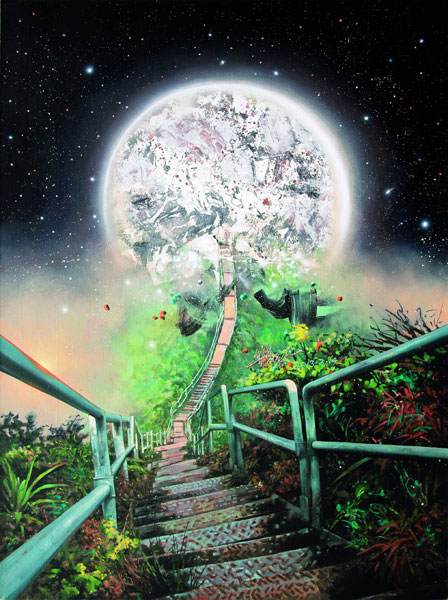Global presence
Updated: 2013-05-31 04:10
By Lin Qi (China Daily)
|
||||||||
 |
|
To the Moon, acrylic on canvas, by Zhong Biao. Photos provided to china daily |
He says that as the Chinese art market took off, more people chose to pursue art as a career.
"While there are not so many exhibitions at home that draw international attention, artists turn to stages abroad that guarantee them more exposure and better communication with the world."
Fan Di'an, director of the National Art Museum of China, says: "The biennale serves as an important front porch for cultural dialogue. The world needs further understanding of the vision of contemporary Chinese art, and its individual characteristics."
But the biennale is not without its problems. Many in the art world question how seriously people should take the art fair and wonder if a lack of cultural confidence lies behind people's excessive expectations of the international art showcase.
"The biennale is just one of the numerous art exhibitions and fairs worldwide," says Huang Du, a Beijing-based independent curator and art critic.
He explains that the culture of biennale has spread to Sao Paulo, Shanghai and Daegu but the curatorial ideas tend to be similar, as a small handful of blue-chip curators tend to travel from one fair to another.
"The biennale used to be the frontline of contemporary art, touching upon social issues and aesthetic changes and encouraging fierce, thought-provoking debates," Huang says. "Now the pioneering spirits and academic strength are withering away. The event has gone too commercial and its authority is questioned."
Huang co-curates a peripheral exhibition titled Enlargement at the biennale.
"The national pavilion has been subject to bureaucratic mechanisms, which interfere with the choice of participating artists. Curators feel exhausted having to compromise in the interest of those trying to put the artists they favor on the list," he says.
He says years after China's official debut at the biennale, contemporary Chinese art still has a weak voice on the international stage.
Sales of contemporary Chinese art experienced a dramatic fall around 2008. Chinese art has suffered over the past five years, which many insiders believe has been painful but necessary.
Wang Chunchen says exhibitions and biennales in China should be upgraded to increase their international influence.
"It depends on cultural openness and more tolerance, and it's essential to the progress of Chinese art. We should rely on ourselves to solve our own problems."
Huang calls on the government to better understand contemporary art, and for society to thoughtfully consider what sort of Chinese culture is needed in today's world.
"Visit museums and galleries in art capitals such as New York, London and Berlin, and people will feel that contemporary art grabs the most attention, for it reflects the creativity and critical thinking of humankind."
He criticizes media that over-hypes Chinese artists and their works at the biennale.
"We seldom listen to what others think about our art.
"The government should establish an effective supporting mechanism for contemporary art. The future of contemporary Chinese art should not be in the hands of some bureaucrats in public art museums," he says.

 Michelle lays roses at site along Berlin Wall
Michelle lays roses at site along Berlin Wall
 Historic space lecture in Tiangong-1 commences
Historic space lecture in Tiangong-1 commences
 'Sopranos' Star James Gandolfini dead at 51
'Sopranos' Star James Gandolfini dead at 51
 UN: Number of refugees hits 18-year high
UN: Number of refugees hits 18-year high
 Slide: Jet exercises from aircraft carrier
Slide: Jet exercises from aircraft carrier
 Talks establish fishery hotline
Talks establish fishery hotline
 Foreign buyers eye Chinese drones
Foreign buyers eye Chinese drones
 UN chief hails China's peacekeepers
UN chief hails China's peacekeepers
Most Viewed
Editor's Picks

|

|

|

|

|

|
Today's Top News
Shenzhou X astronaut gives lecture today
US told to reassess duties on Chinese paper
Chinese seek greater share of satellite market
Russia rejects Obama's nuke cut proposal
US immigration bill sees Senate breakthrough
Brazilian cities revoke fare hikes
Moody's warns on China's local govt debt
Air quality in major cities drops in May
US Weekly

|

|







